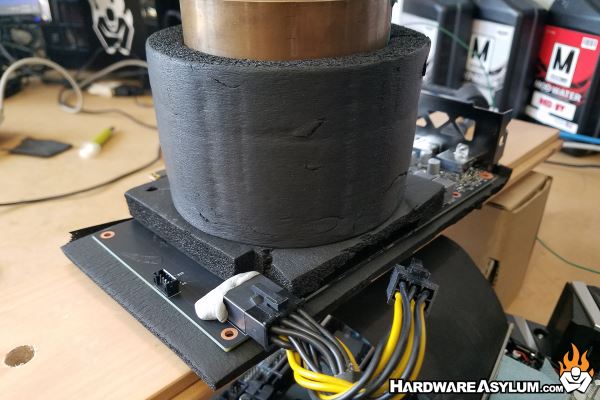EVGA RTX 2060 KO Video Card Review and LN2 Overclocking
Author: Dennis GarciaSubzero Card Prep
With the cooler removed we can prep this card for some subzero cooling. For video cards I prefer using liquid electrical tape. This is a liquid rubber that will dry to create a water and airtight seal. If you apply it thick enough it is also easily peeled away with very little residue left behind.
In my previous photos you’ll see where some of the liquid tape was left after I peeled it off, most came off in a single piece.

This was done to both the front and back of the card and since the gpu wasn’t going to get that cold I only applied it around the memory. I’ll be using some kneaded eraser and paper towels for the rest.
As I mentioned before the additional capacitors proved to be a problem for getting an LN2 pot on this card so I decided to use my CPU container instead and connect the card to the motherboard using a vertical GPU ribbon cable.

The card was placed on a bit of insulating foam to both protect the card and prevent the back of the card from frosting up. The card was then held in place with a wood block and some cardboard boxes. The weight of the CPU container provided enough stability to keep the card from moving and made a good connection with the GPU.

Insulation was placed at the base of the container and cut around the existing components including the capacitors and power connection.
The rest just worked.
Again, by now we all know the basic performance of the RTX 2060 and should also know that internal power regulation prevents any RTX card from delivering more power than allowed by NVIDIA. Some cards offer more power while others are locked to a single figure.
So the question is, what happens when you exceed the power limits of these cards?
Well, two things. Typically a normal video card will crash and artifact when you push it beyond what is can support. This is typically what happens with air and water cooling where the chip is locked by temperature and voltage. If the chip is good it will overclock well, if it is bad, not so much. Assuming we have a good chip we can start exploring different clock speeds and with the right power and voltage they can clock quite well.
That is until OCP kicks in. Just about every video card has a lock preventing excessive current from passing through the card. OCP is Over Current Protection and is how both NVIDIA and the Manufacturer can throttle performance either to prevent damage to the card or keep the cards within a certain thermal envelope.
When the GPU hits this limit the clocks are throttled back limiting performance.
One of the driving principles of LN2 overclocking is to make chips more power efficient so they will run faster at certain voltage settings and that is the purpose of this little experiment.

